In fundraising, understanding pledge vs. donation can be an essential distinction. There are many pros and cons for nonprofit organizations to consider.
Nonprofits may collect pledges during fundraising appeals, capital campaigns, and events. The big difference is that donations are collected now, and pledges are a promise from a supporter to make a gift later.
While donations mean an immediate exchange of money or items, a pledge may hold the possibility of gaining a more significant gift and raising more money.
Each organization must consider how they record pledges and who is responsible for following up with the donor to collect the donation.
While automation can assist with reminders for pledges, your team must collaborate to create a plan for managing pledges. The finance department and development department may view pledges differently.
Start by deciding whether your organization will accept pledges and determining the maximum timeframe for fulfillment. Many nonprofits choose large campaign pledges fulfilled within three years. For direct mail appeals, these are often a monthly contribution.
Next, determine a process to collect pledges, such as on a pledge card or online donation page. Lastly, create a plan for pledge reminders and stewarding donors.
Pros and Cons of pledges and donations in your fundraising campaign
Donations have many pros to consider. Made as a one-time gift, donations are simple. The donation is processed at the time of the gift, and the donor is sent a thank you and tax receipt.
While seasoned fundraisers know that the relationship only begins with the gift and we must continue to steward donors, the main requirements of accepting donations have been fulfilled once the tax receipt is sent.
One con of a donation vs. pledge is that the donor may have limited ability to give at that time. The amount of money they can give at one time may be less. For some donors, a pledge amount may be higher than a one-time donation.
Pledges have many pros, including the potential for many donors to give more. The same donor who chooses to donate $100 as a one-time gift might consider a pledge of $10 per month. This increases their annual gift by $20.
If your organization had 100 or more donors who did this, it would make a considerable impact. There is a bonus to the donor feeling extra generous.
On a larger scale, a one-time donor might give $10,000 during a capital campaign, but that same donor might consider giving $10,000 for three years total if provided this option.
The primary consideration or con to a pledge campaign is the staff time involved with tracking and collecting donations. Do you have enough staff or automation tools to send pledge reminders?
There is also a possibility that not all pledges will be collectible. Consider what percentage of doubtful pledges you might have each year and communicate this to your finance department.

Sample: Pledge card with ask amounts

Sample: Pledge card with donor information
Determine How You Will Collect Pledges
The most common way to collect pledges is on a pledge card. A well-designed pledge card can help raise more money and streamline donation processing.
The pledge card should do the heavy lifting of the ask during any nonprofit organization’s direct mail fundraising campaign. A pledge card lists an ask string for one-time donations and a pledge of monthly gift increments. A tool such as AskGenius can help set individualized ask strings for every donor.
Some apps allow the organization to choose how to break down the pledge. Some may allow 10-12 monthly increments throughout the year.
Setting ask strings customized to each donor can help raise significantly more money during a direct mail appeal. A good pledge card must be paired with a personalized fundraising letter that makes the donor the story’s hero.
A fundraising letter should tell a heartfelt story in 2-4 pages and help the donor understand the impact they can make. It uses familiar language and an easy-to-read font.
A strong appeal, whether a pledge campaign or request for one-time donations, should be coupled with an email nourishment campaign and social media posts.
Nonprofit organizations may also consider social media or text-to-give campaigns for collecting both donations and pledges.
Check out these tools to get started today
After considering the pros and cons of pledge vs. donation in your fundraising campaign, check out a demo of AskGenius or AutomateGenius to see how these tools can maximize your staff’s time and streamline fundraising functions.
And for more information on pledge cards, check out The Ultimate Guide to Fundraising Pledge Cards – AskGenius.
